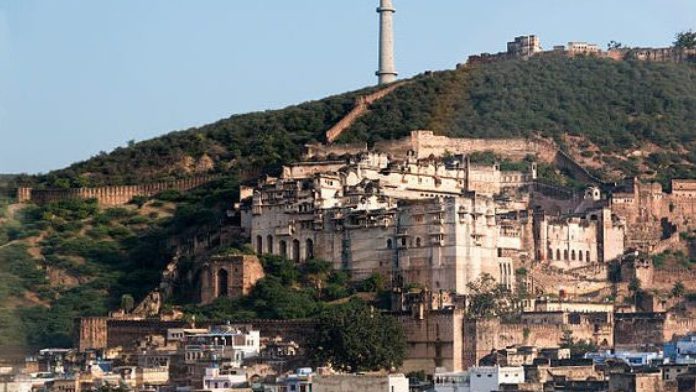The Ministry of Tourism’s Dekho Apna Desh Webinar series titled “Bundi: Architectural Heritage of a Forgotten Rajput Capital” on 24th October 2020 focused on Bundi, Rajasthan. In shadows of erstwhile power centres of medieval India, are small historic towns largely unknown today beyond their immediate geographical context.
While considerable focus has been garnered on major historic imperial and provincial cities of India like Delhi, Jaipur, Jaisalmer, Udaipur, Ahmedabad, Lucknow etc., the smaller cities and towns spread across vast unvisited hinterland of India have received less than deserved attention of tourists, enthusiasts and scholars.
Bundi erstwhile capital of Hada Rajput province known as Hadauti located in south-eastern Rajasthan, is one such place. The webinar, presented by Charudatta Deshmukh, an Architect-Urban Planner, explained a comprehensive understanding of the wealth of architectural heritage of reasons and conditions influencing its creation, challenges being faced by it in 21st century, utilisation of architectural heritage of Bundi as primary driver for growth of Tourism in Bundi and in south-eastern Rajasthan.
Bundi is also known as City of stepwalls, blue city and also as Chotti Kashi. In ancient times, the area around Bundi was apparently inhabited by various local tribes, of which the Parihar Tribes, Meena was prominent.
Best example of medieval Indian city exhibiting water harvesting methods adopted at settlement level as well as finest examples of water architecture. Location of Baoris and Kunds outside the walled city was also influenced by social considerations as ascess to baoris and kunds were located within walled city was controlled.
Architectural heritage of Bundi can be classified in six typologies: –
1) Garh (Fort) -Taragarh
2) Garh Mahal (Royal Palace) -Bhj Mahal, Chattar Mahal and Ummed Mahal
3) Baori (Step well) – Khoj Darwaja ki Baori and Bhawaldi Baori
4) Kund (Stepped tank) – Dhabhai ji ka Kund, Nagar Kund & Sagar Kund and Rani Kund
5) Sagar mahal (Lake Palace) – Moti Mahal, Sukh Mahal, Shikar Burj and
6) Chhatri (Cenotaph) – Chaurasi
Taragarh Fort- Taragarh Fort was constructed by Rao raja Bair Singh in 1354 on a hilltop 1426 feet high. In the centre of the fort is located Bhim Bhurj on which was once mounted a particularly large cannon called Garbh Gunjam, or ‘Thunder from the Womb’. With its curved roofs topping pavilions, excess of temple columns and elephant and lotus motifs, the palace is a tribute to Rajput style. The fort includes Hazari Darwaza, Haathi Pol, Nau Dhaan, Ratan Daulatkhana, Darikhana, Ratan Niawas, Chatra mahal, Badal Mahal & Moti Mahal.
Sukh Mahal– A small, two-storied palace was a summer retreat of past rulers. Located on banks of JaitSagar lake, the palace was constructed by Rao raja Vishnu Singh in 1773 A.D.
Rani Ki Baori- Bundi has more than 50 stepwells and rightly known as city of stepwalls . Raniji ki Baori, also known as ‘Queen’s Stepwell’, is a famous stepwell built in 1699 by Rani Nathavati Ji, the younger queen of the ruling king Rao Raja Anirudh Singh of Bundi. This multi-storied stepwell displays excellent carvings of Gajraj with his trunk turned inwards, giving the impression of having drunk from the baori on its pillars. Its high arched gate gives it an inviting appearance.
84 Pillared Cenotaph– As the name suggests, the 84 Pillared Cenotaph is a structure supported by 84 columns. Commissioned by Rao Anirudh, the Maharaja of Bundi, this cenotaph was constructed in memory of his nurse, Deva, under whose love and guidance the prince grew up. A popular tourist attraction, this impressive structure is decorated with carvings of deer, elephants and apsaras.
Travellers have good number of places to explore in Bundi with good number of budget hotels. Vegetarians can enjoy Dal Bhati and various types of spicey chutneys.
Summing up the webinar Rupinder Brar, Additional Director General stressed on the importance of travel and explore destinations, cuisines, culture and heritage. The Ministry of Tourism’s Incredible India Tourist facilitator certification programme act as an enabler for transforming a local citizen with no specified skills having proficiency in a regional language into a potential bread earner for their households. This will further help citizens to own up the local heritage, folklore and culture and show it to the visitors.








